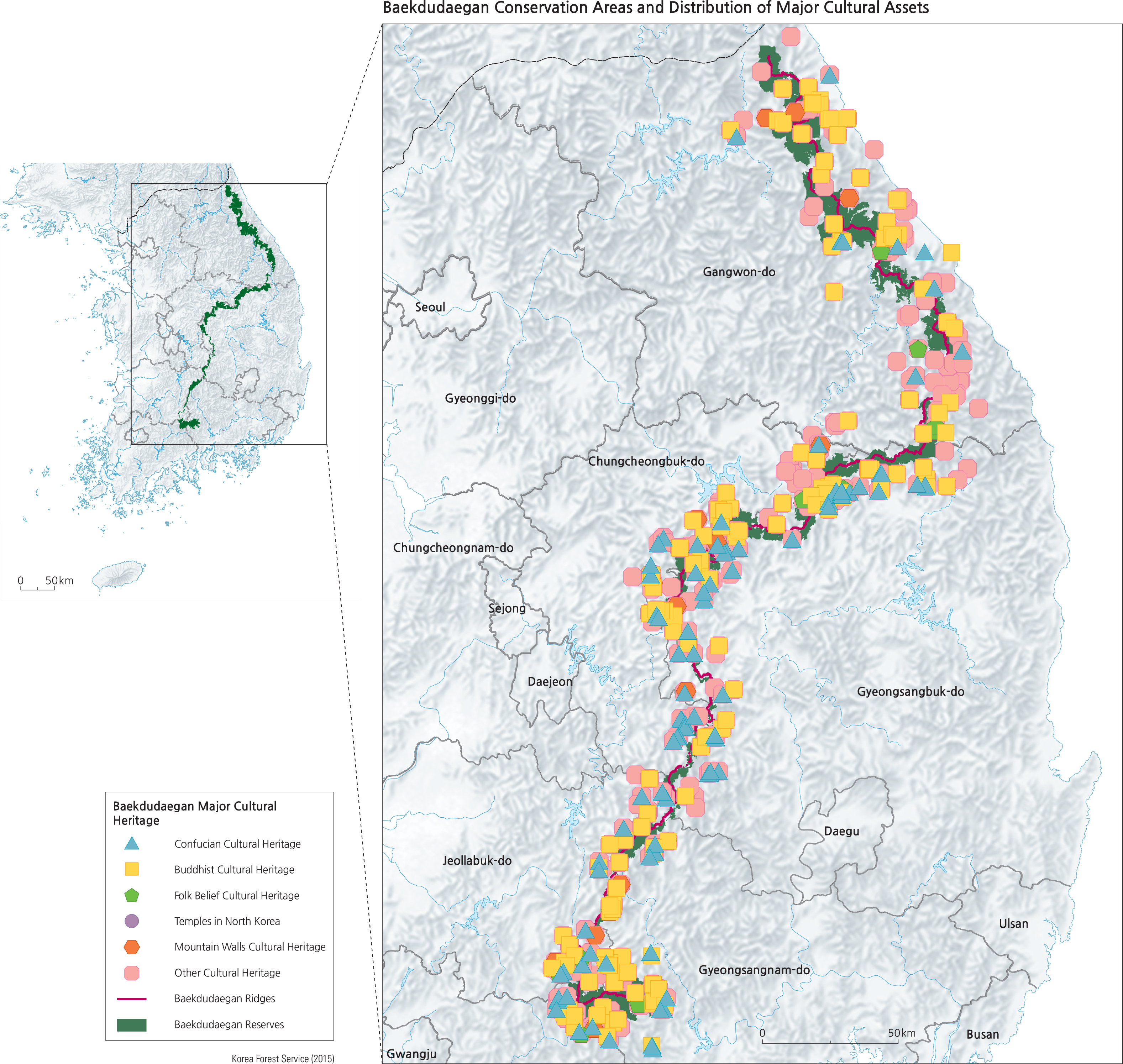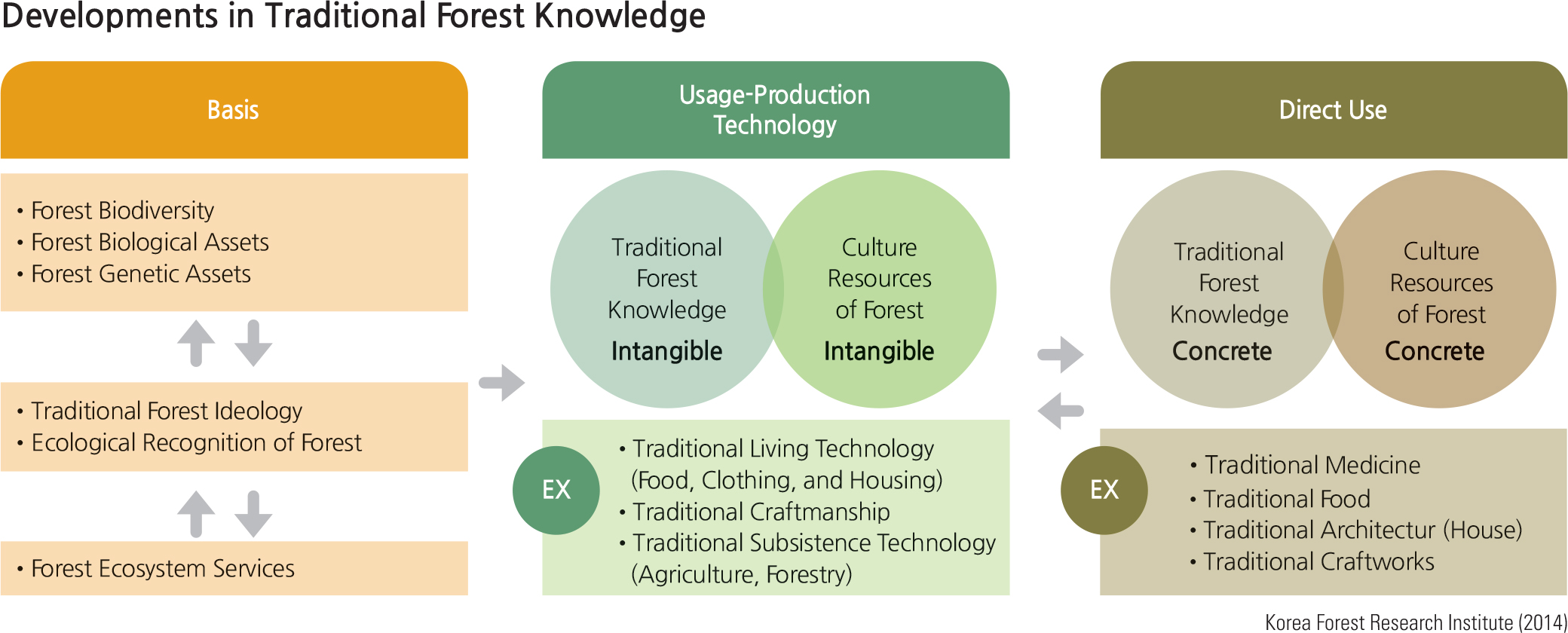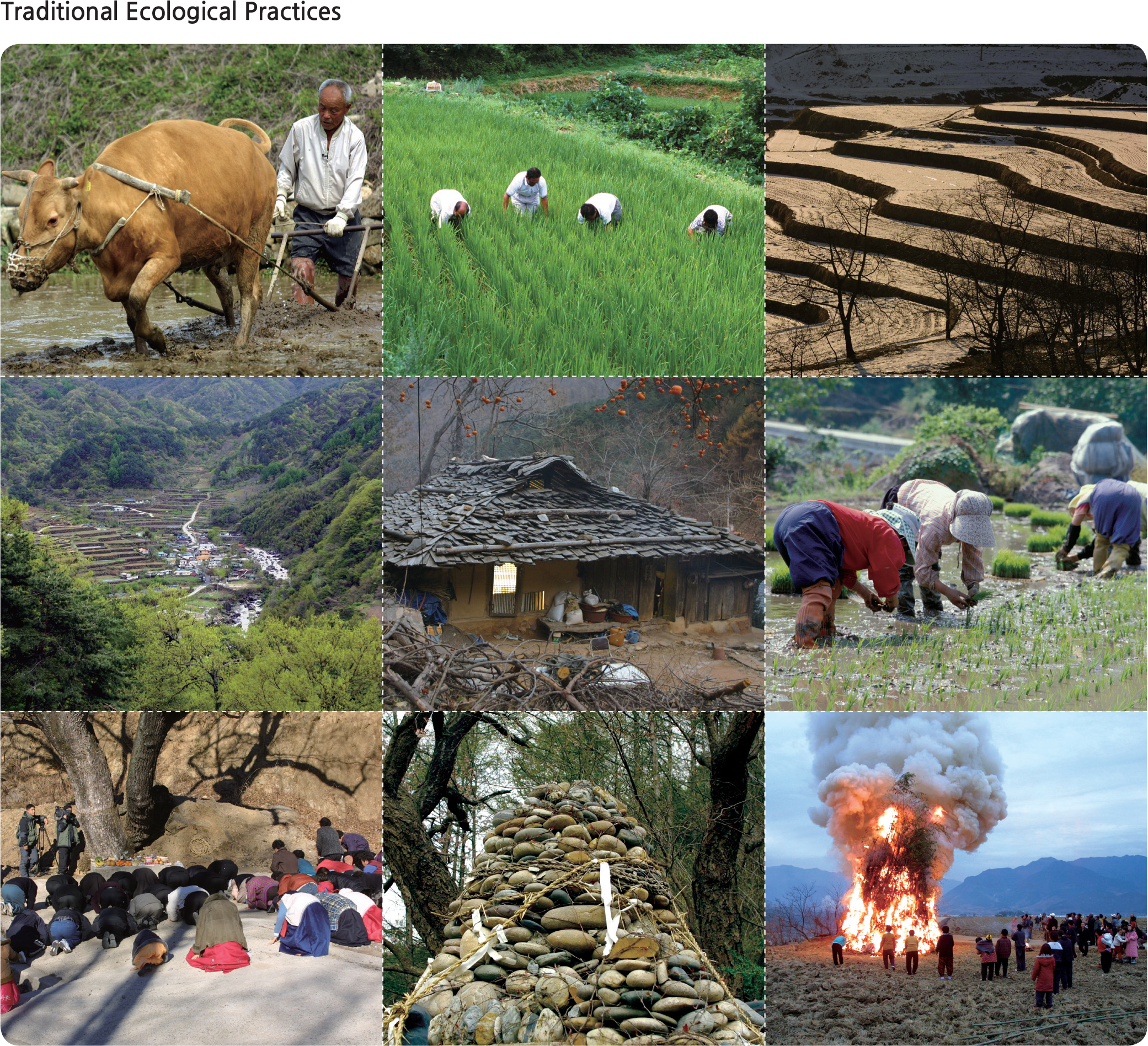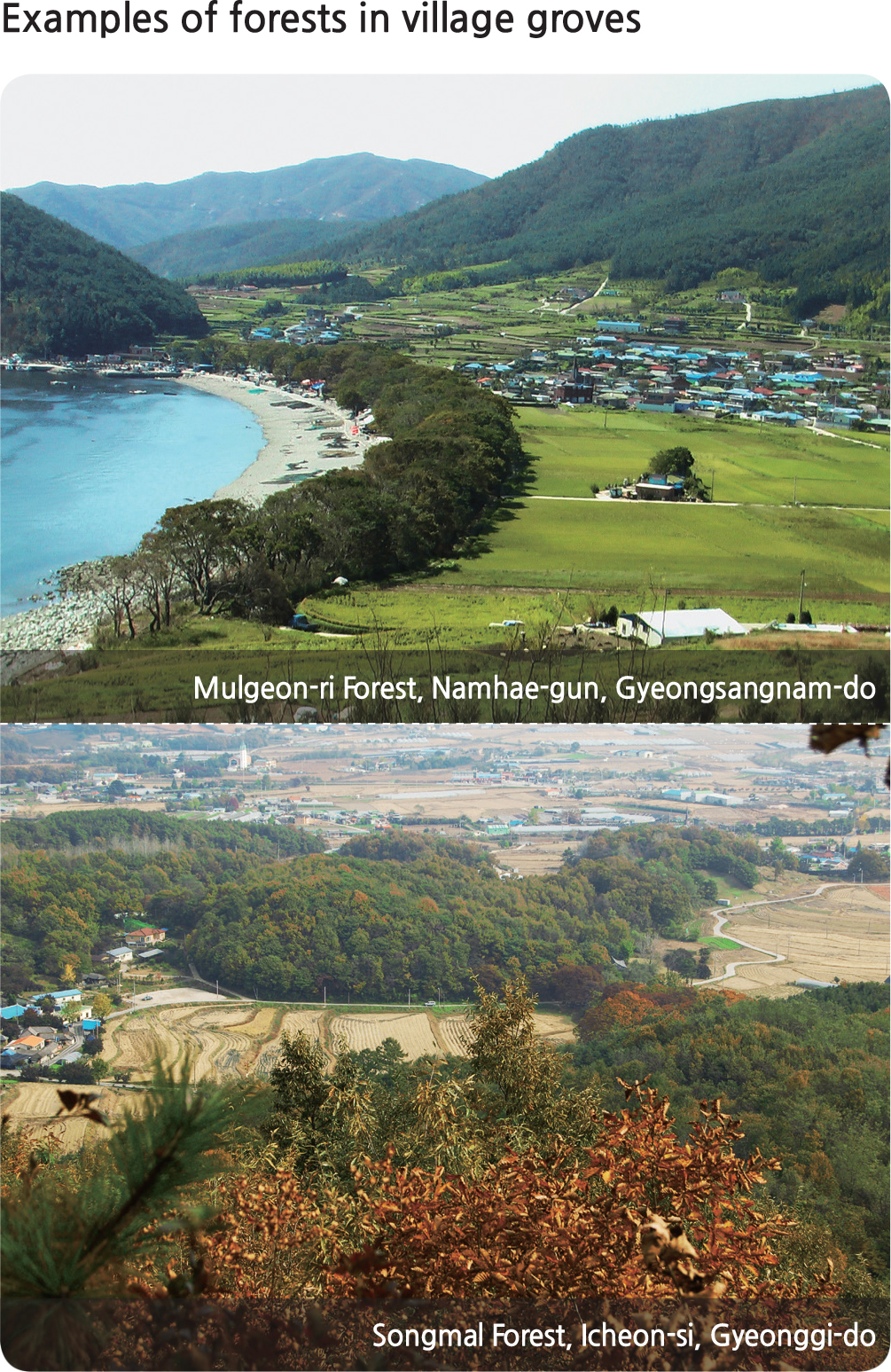The term “Traditional Ecology” refers to long-standing ways humans have adapted to the environment of the land and how to use surrounding physical and biological environments for human survival and livelihood. In Korea, the geographical perception of the Baekdudaegan Mountain Range represents the most important traditional ecology. The mountain range and riverine system of Baekdudaegan served as a fundamental base for understanding the people, philosophy, literature, ecology, and culture of the Korean Peninsula.
As of 2015, about 64% of South Korea was covered with forest. Most forests are connected to the Baekdudaegan mountain chain which has long been a central axis of the Korean eco-cultural space and spirit. The designation of the Baekdudaegan as a protected area supports the identity of the Korean people and their willingness to maintain mutual dependency with oceanic and continental ecosystems.
The protection area of Baekdudaegan is extremely valuable in terms of the Korean cultural and spiritual history. Each major mountain boasts temples that entwine Buddhist culture with impressive landscapes long before foreign religions arrived in Korea. The area houses both tangible and intangible cultural heritage values and assets. There are 543 state-designated cultural assets, including 31 national treasures, 273 treasures, and 49 historic sites. There are also 965 province-designated heritage assets, 523 cultural and historical documents, 53 registered cultural heritage sites, and so forth. In particular, temple in situ forests play a central role in enhancing the spiritual value of the protection area. Out of the 935 traditional temples in Korea, 173 (19%) are located in Baekdudaegan. Baekdamsa (Seoraksan), Woljeongsa, Sangwonsa (Odaesan), and Hwaeomsa (Jirisan) are the main temples well known to the public. They contain approximately 16,571 ha of temple-centered forests which accounts for 6% of the total protection area in Korea.
In additional to its cultural assets, the Baekdudaegan ecosystem is home to very diverse wildlife, including 126 families, 541 genus, and 1,248 species of flora and 23 species of mammals, 91 bird species, 11 species of amphibians, and 6 reptile species.
The industrialization and urbanization of modern society have caused various environmental problems and accelerated changes of the climate and natural ecosystems. The ecological knowledge and resource management practices handed down from traditional cultures have gained attention as an important legacy to aid in solving environmental problems as well as managing and distributing resources.
Korean traditional villages took the concept of the Baesanimsu (“with back to the mountain and face to the water”) as the basic principle to guide settlement location and land use. Also, this principle greatly benefited villagers who, as a result, lived within well-secured watersheds with access to water, protection against the wind, and accessibility to resources. The traditional villages were adapted to the local natural conditions and existed in a harmonious relationship with the surrounding natural ecosystems, resulting in their ability to maintain that spatial arrangement for a long period of time. One good example is the maeulsoop (Korean village grove).
A maeulsoop or village grove is a small forested area that helps the people adapt to the monsoon climate and helps the village to harmonize with the surrounding environment. The grove is a part of the village landscape, or is a property co-owned with and protected and managed by villagers. A village grove is a common gathering place for villagers and provides shelter for people during the hot summer. Further, it is a sacred site and holy place that the villagers protect and where they periodically perform ancestral rites.
Big trees such as pine and zelkova grow in the groves. Many species of birds, such as mandarin duck, scops owl, owl, woodpecker, great tit, and starling, which normally live deep in the mountain forests and build nests in the hollows of tree trunks and branches, inhabit the area and are frequently observed near the village.
The oldest village grove in Korea is Daegwallim which dates back to about 887–897 A.D. and is now protected as Natural Monument No. 154. By September, 2014, the Korea Forest Service had studied and organized information for the village groves in 1,335 regions. They found that the major plant species of village groves are Pinus densiflora and Zelkova serrata.
Traditional forest knowledge is defined as an integral aspect of the cultural heritage, ecological (genetic) resources, and traditional wisdom that a particular region or a group of people (tribe or ethnic group) has passed down over the generations. Based on this valuable preservation, Korea has developed the usage, production, and related technology for traditional knowledge. Recently, efforts have been made to classify traditional forest knowledge into 5 categories (humanities, forest philosophy, natural environment, production techniques, and social-economic policy) to fit the international trend towards the traditional knowledge-related International Patent Classification.
Among this wealth of traditional knowledge is one relating to the collection and processing of acorns for food. The Korean word dotori for acorn is a compound word derived from “dot” (boar) and “tol” (nut), meaning a kind of nut that wild boars like to eat. Korean people use acorns for food today. Archaeological sites on Sejuk beach in Ulsan produced evidence that people dug holes regularly to get rid of acorn tannins with sea water to make food with acorns as far back as 6,000 BC. Historical records cite King Sejong in 1424 who ordered that people “keep a good number of acorns in reserve for famine years.” He also commanded people to plant oak trees as a hardy plant when crop production was not sufficient. The Injeji of Imwon gyeongjeji (the largest practical encyclopedia of the Joseon Dynasty), explains how people could plant oak trees and take care of them. Boncho gangmok (the book of Chinese medicinal herbs) describes acorns as “neither crop nor fruit, but having merits of both, a good diet without any supplementary tonic.” Thus, sawtooth oak (Q. acutissima), which have bigger acorns and are more productive than all the other oak tree species, are generally found near villages rather than in high mountains. Sawtooth oak inhabits temperate forest regions with annual mean temperatures ranging from 5 to 14 ˚C below an elevation of 800 m.
Brief Interpretation of the Map
Buddhists have always sought places of tranquility and seclusion to build temples where monks can stay and pray in harmony with nature. Over the centuries, a large number of temples and cultural places have been built along the crest of the Baekdudaegan mountain chain where forests and wildlife are abundant. It is this spiritual setting that preserves the identity of Buddhist believers in Korea. A traditional way of life is also maintained here as opposed to the busy hustle and bustle of urban areas where everyday life is much more rushed and stressed. The mountains are a perfect place to pass on traditional forest knowledge to later generations. Although the ways modern society preserves agricultural and ecological knowledge are different, Koreans believe there is still wisdom in the traditional forest knowledge that can be tapped to solve environmental problems.
While preserving traditional forest knowledge is important to the heritage of Korea, spatial conditions change away from the mountains. The practice of Baesanimsu (“with back to the mountain and face to the water”) supplies water and protects farms from winds in mountainous areas, but such conditions are not available in the lowlands. What kind of adaptations can you imagine would be required to maintain the practice of Baesanimsu when one moves out of the mountains into the western lowlands of Korea? Are modern farming methods using machinery on larger fields more appropriate for flat lowlands? Can both methods coexist at different spatial conditions?




